Artemisia lactiflora Guizhou Group
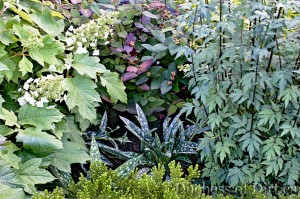 Artemisia lactiflora Guizhou Group
Artemisia lactiflora Guizhou Group
(ar-tay-MIS-ee-ah lak-tih-FLO-rah)
syn. Artemisia lactiflora ‘Guizhou’
Family: Asteraceae
Common name: white mugwort; purple ghost mugwort
Zone: 5 – 8
Height: 4-5 ft (1.2-1.5 m)
Spread: 2 ft (0.6 m)
Aspect: partial shade
Soil: fertile; moist; well-draining
Water: moderate
Description: An herbaceous perennial with a bushy, upright, clump-forming habit. Black-green leaves are quite fern-like with their deeply incised lobes. Sprays of creamy-white flowers appear atop deep maroon-purple stems in late summer through autumn.
Special Notes: This is an improved form of Artemisia lactiflora which was discovered on a 1985 Sino-British expedition to Guizhou Province in China. Introduced as Artemisia #GUIZ137. Good cut flower. Relatively pest- and disease-free. Powdery mildew may be a problem in some climates. Deer and rabbit resistant. Propagate by division in early spring or autumn.
In our Zone 7a garden: This is a stellar performer and a delightfully worry-free plant for us. It also is where we can often find lots of baby slugs hiding out in the spring. The slugs do not eat the leaves…much preferring the ferny, distinctively-coloured foliage for its great camouflage coverage. You have to look hard to find their small, slimy, soft beige bodies hiding within the plant’s clump-forming habit. So a word to the wise, DO NOT place any plants that slugs love to feed on…such as hostas, lettuces and ligularias…in the near vicinity of your Artemisia lactiflora ‘Guizhou’.
Great Plant Pick 2011
Posted on April 18, 2013; updated on August 7, 2024
Arrhenatherum elatius var. bulbosum ‘Variegatum’
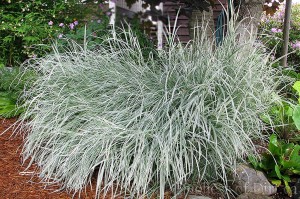 Arrhenatherum elatius var. bulbosum ‘Variegatum’
Arrhenatherum elatius var. bulbosum ‘Variegatum’
(ah-ren-AH-the-rum ay-LAH-tee-us var. bul-BOW-sum)
Family: Poaceae
Common name: variegated bulbous oat grass; variegated false oat grass
Zone: 4 – 8
Height: 12-15 in (30-35 cm)
Spread: 18-24 in (45-60 cm)
Aspect: full sun; partial shade
Soil: average; well-draining
Water: moderate
Description: An herbaceous perennial grass with a tuft-forming habit. Hairless, slender, grey-green leaves are edged in creamy white. Pale green spikelets appear in summer, changing to straw brown colour in autumn.
Special Notes: Native to Europe. This grass increases in size with the formation of chains of yellow bulb-like swellings developing at the base of the stems. Growth is relatively slow and easy to control, however. Remove old foliage in late winter before new leaves emerge. Generally, pest- and disease-free. Deer and rabbit resistant. Propagate by division in early spring or autumn.
Posted on April 18, 2013; updated on August 7, 2024
Aronia melanocarpa
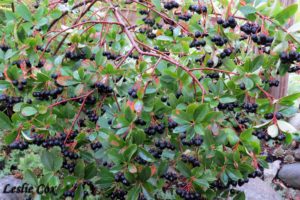 Aronia melanocarpa Family: Rosaceae
Aronia melanocarpa Family: Rosaceae
(ah-ROE-nee-ah mel-an-oh-KAR-pah)
Common name: black chokeberries
Zone: 3 – 8
Height: 3-6 ft (0.9-1.8 m)
Spread: 6-10 ft (1.8-3 m)
Aspect: full sun; partial shade
Soil: average; well-draining
Water: moderate
Description: A medium-sized, deciduous shrub with a fairly low, spreading growth habit. The dark green, glossy leaves are obovate in shape with a rounded tip. Colour turns a wonderful purplish-red in autumn. Clusters of 5-petaled white flowers open for a short bloom period in May, followed by dark, round, edible berries in autumn. Berries first appear dark purple, maturing to black when fully ripe.
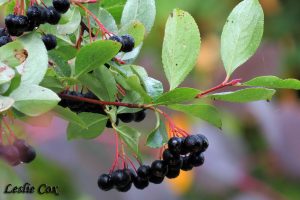 Special Notes: Native to North America, primarily the area around the Great Lakes in Canada and the United States. Once used by the native peoples as a meat preservative in preparing pemmican. More recently, it has been discovered aronia berries have wonderful health benefits. Besides being saturated with natural anti-fungal, anti-bacterial, and anti-diabetic qualities, the berries are rich in anthocyanins and polyphenols…which protect the urinary tract, stimulate the circulation and strengthen the heart. Ongoing studies are showing black chokeberries also contain compounds helpful in fighting certain cancers and heart disease. There is also ongoing research on its benefits for memory loss and cognitive deterioration.
Special Notes: Native to North America, primarily the area around the Great Lakes in Canada and the United States. Once used by the native peoples as a meat preservative in preparing pemmican. More recently, it has been discovered aronia berries have wonderful health benefits. Besides being saturated with natural anti-fungal, anti-bacterial, and anti-diabetic qualities, the berries are rich in anthocyanins and polyphenols…which protect the urinary tract, stimulate the circulation and strengthen the heart. Ongoing studies are showing black chokeberries also contain compounds helpful in fighting certain cancers and heart disease. There is also ongoing research on its benefits for memory loss and cognitive deterioration.
Aronia melanocarpa has few insect or disease problems, although there is some susceptibility to leaf spots…merely a cosmetic problem. Twig and/or fruit blight could also be a slight problem.
 In our Zone 7a garden: Our Aronia shrub sits at the corner of the raised bed by the steps leading up to the pond…and beyond. It was relocated to this location in 2013 after being deemed unsuitable in the first spot John placed it when the plant was purchased in 2011. I only mention this so you have some understanding its current size of about 3 feet (0.9 m) tall and roughly 5 feet (1.5 m) wide may not be its final stature. However, this shrub does lend itself to being kept in check through some judicious pruning.
In our Zone 7a garden: Our Aronia shrub sits at the corner of the raised bed by the steps leading up to the pond…and beyond. It was relocated to this location in 2013 after being deemed unsuitable in the first spot John placed it when the plant was purchased in 2011. I only mention this so you have some understanding its current size of about 3 feet (0.9 m) tall and roughly 5 feet (1.5 m) wide may not be its final stature. However, this shrub does lend itself to being kept in check through some judicious pruning.
This past fall (2016), I managed to beat the birds to the berries. (Warning: you must be quick! As soon as the birds…mainly robins in our garden…pronounce the berries are finally ripe enough to eat, the entire shrub is harvested in two days…three at the very outside.) I froze all of this year’s harvest in batches on a waxpaper-lined cookie sheet and transferred the frozen berries into freezer bags for later use in smoothies. Delicious.
Posted on December 17, 2016; updated on August 6, 2024
Arisarum proboscideum
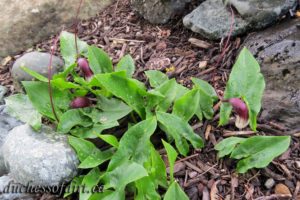 Arisarumproboscideum Family: Araceae
Arisarumproboscideum Family: Araceae
(ay-ri-SAR-um pro-bos-SID-ee-um)
Common name: mouse plant; mouse tail plant
Zone: USDA 7 – 9
Height: 4 – 6 in (10-15 cm)
Spread: 18 in (45 cm)
Aspect: part to full shade
Soil: humus-rich; moist; well-drained
Water: moderate; drought tolerant
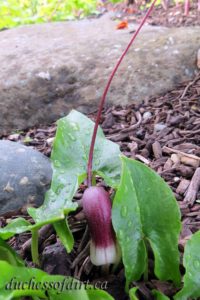 Description: An herbaceous, tuberous-rooted, ground-hugging woodland perennial with glossy green, arrowhead-shaped leaves. Flowers are maroon and white with a unique tail-like tip which can stretch to 6 inches (15 cm). The whole floral effect is of the back end of a mouse diving underground with its tail waving in the air.
Description: An herbaceous, tuberous-rooted, ground-hugging woodland perennial with glossy green, arrowhead-shaped leaves. Flowers are maroon and white with a unique tail-like tip which can stretch to 6 inches (15 cm). The whole floral effect is of the back end of a mouse diving underground with its tail waving in the air.
Special Notes: Native to Spain and Italy, this plant is related to Arisaema triphyllum (jack-in-the-pulpit) which is native to eastern North America. It is winter hardy to USDA Zone 7…Zone 6 if given some protection. This is a spring ephemeral, appearing in early spring and disappearing below ground in the heat of summer.
Flowers are complete… having both male and female sexual organs. Fertilization is accomplished when the flowers attract small fungus gnats which subsequently become trapped within the flower and, in their struggle to escape, they inadvertently spread pollen from the male organs to the female.
Relatively drought tolerant once established. Pest and disease resistant.
In our Zone 7a garden: First signs of emergence start in the first two weeks of spring with tiny green spires of furled leaves appearing. Flower stems and buds show up shortly after. Bloom time begins about the second week of April and lasts remarkably well through to about the end of June. As soon as the heat really begins to ramp up, the whole clump disappears until the following spring.
I should mention…my one clump of mouse plant is situated in almost complete shade. Sun only reaches it in late winter and early spring and number of duration days only extends until the surrounding herbaceous perennials appear and leaf out and the chestnut tree leaves reach out to full canopy limit.
Great Plant Pick (GPP) 2008
Posted on April 2, 2020; updated on August 6, 2024
Aquilegia vulgaris ‘Woodside Gold’
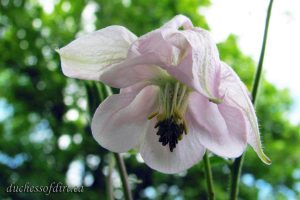 Aquilegia vulgaris ‘Woodside Gold’
Aquilegia vulgaris ‘Woodside Gold’
(a-kwi-LEE-jah vul-GAR-is)
syn. Aquilegia vulgaris ‘Woodside Golden’; Aquilegia vulgaris Woodside Strain
Family: Ranunculaceae
Common name: columbine; granny’s bonnet; European crowfoot
Zone: 3 – 8
Height: 2 – 3 ft (60 – 90 cm)
Spread: 1 – 1.5 ft (30 – 45 cm)
Aspect: sun; partial shade
Soil: average; humus-rich
Water: moderate
Description: An herbaceous, small clump-forming perennial with thin, branching stems adorned with golden scalloped leaves. Somewhat upward-facing, short-spurred, soft pink flowers appear in early April through into late May or early June. Attracts bees and hummingbirds.
Special Notes: Native to Europe, Aquilegia vulgaris has been grown in gardens for centuries. Over the years, the plant has escaped its garden boundaries and become naturalized, both in its native region and in North America.
Given optimum growing conditions and regular water, the plant will develop a lovely clump. It readily self-seeds which ensures this purported short-lived perennial will enjoy many years in the garden. Easy care.
Drought tolerant once established. Attracts bees and hummingbirds. Deer and rabbit resistant, however slugs and aphids may be a problem. Leaves are susceptible to leaf miner.
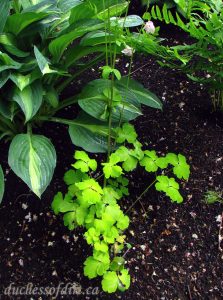 In our Zone 7a garden: I have a clump of ‘Woodside Gold’ in my island bed where it is mostly in shade and competes with big tree roots. The leaves hold their gold colour quite well, only slightly darkening to a green-gold colour as the season progresses. Being in the shade, the flowers on mine are a lovely soft pink colour.
In our Zone 7a garden: I have a clump of ‘Woodside Gold’ in my island bed where it is mostly in shade and competes with big tree roots. The leaves hold their gold colour quite well, only slightly darkening to a green-gold colour as the season progresses. Being in the shade, the flowers on mine are a lovely soft pink colour.
John has a clump in his back garden where it gets a fair amount of sun throughout the day. The leaves on this clump turn a green-gold colour quicker than those in my garden and the flowers are more of a dusky-rose colour. We both cut the leaves down to the ground as they get ratty-looking later in the season.
Posted on February 13, 2023; updated on August 6, 2024
